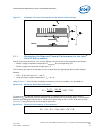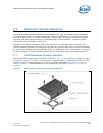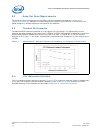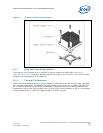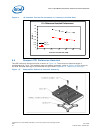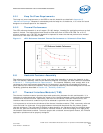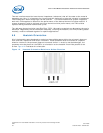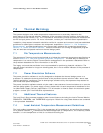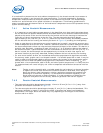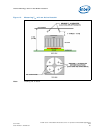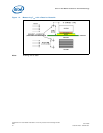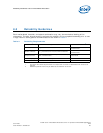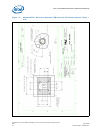
Intel® Core™ 2 Duo Mobile Processors on 45-nm process for Embedded Applications
June 2008 TDG
Order Number: 320028-001 24
Thermal Metrology—Core™ 2 Duo Mobile Processors
7.0 Thermal Metrology
The system designer must make temperature measurements to accurately determine the
performance of the thermal solution. Validation of the processor’s thermal solution should be done
using a thermal test vehicle (TTV). The TTV allows for an accurate junction temperature measurement
as well as input power control. For more information, contact your Intel field sales representative.
In addition, the processor’s heatsink should be verified in a system environment. Intel has established
guidelines for techniques to measure the component temperature. Section 7.1, “Die Temperature
Measurements” provides guidelines on how to accurately measure the component temperature.
Section 7.2, “Power Simulation Software” contains information on running an application program
that will emulate anticipated maximum thermal design power.
7.1 Die Temperature Measurements
The component T
JUNCTION
must be maintained at or below the maximum temperature specification as
noted in Section 3.2, “Maximum Allowed Component Temperature” . The best way to measure die
temperature is to use the Digital Thermal Sensor as described in the processor’s datasheet. Refer to
the processor datasheet for more information on the DTS.
The legacy on-board thermal diode is not recommended for performing heatsink validation. The
thermal diode is suitable for long term trending data, but is not a reliable indicator of the processor’s
temperature.
7.2 Power Simulation Software
The power simulation software is a utility designed to dissipate the thermal design power on a
processor. To assess the thermal performance of the processor thermal solution under “worst-case
realistic application” conditions, Intel is developing a software utility that operates the processor at
near worst-case power dissipation.
The power simulation software should only be used to test customer thermal solutions at or near the
thermal design power. For power supply current, please refer to each component’s datasheet for the
I
CC
(Max Power Supply Current) specification. For information on how to obtain the maximum power
program, contact your Intel field sales representative.
7.3 Additional Thermal Features
The Intel Core 2 Duo processor supports other thermal features including the Intel
®
Thermal Monitor,
PROCHOT#, FORCEPR#, and THERMTRIP# signal pins. Details for using these features are contained
in the processor datasheet.
7.4 Local Ambient Temperature Measurement Guidelines
The local ambient temperature (T
LA
) is the temperature of the ambient air surrounding the processor.
For a passive heatsink, T
A
is defined as the heatsink approach air temperature; for an actively cooled
heatsink, it is the temperature of inlet air to the active cooling fan.



